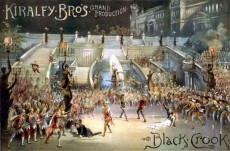
From Broadway To 52nd Street
Though no jazz standards came out of the musical, The Black Crook took the stage on September 12, 1866 and shocked, outraged and totally delighted American audiences. It was the first long running musical hit with a record 475 performances. Though often at odds with the Puritan morality that underwrote the founding of this nation, a new totally American art form, the Broadway musical, was born.
The Story: Set in 1600 in the Harz Mountains of Germany where evil, wealthy Count Wolfenstein seeks to marry the lovely village girl, Amina. With the help of Amina’s scheming foster mother Barbara, the Count arranges for Amina’s fiancé, Rodolphe, an impoverished artist, to fall into the hands of Hertzog, an ancient, crook-backed master of black magic. Hertzog has made a pact with the Devil (Zamiel, “The Arch Fiend”): he can live forever if he provides Zamiel with a fresh soul every New Year’s Eve. As Rodolphe is led to this horrible fate, he escapes, discovers a buried treasure, and saves a dove. The dove magically turns out to be Stalacta, Fairy Queen of the Golden Realm, who is pretending to be a bird. The grateful Queen rescues Rodolphe by bringing him to fairyland and then reuniting him with his beloved Amina. The Count is defeated, demons drag the evil Hertzog into hell, and Rodolphe and Amina live happily ever after.
Broadway History: The bastion of artistic collaboration, Broadway is the quintessential stage experience that marks the pinnacle of excellence between writer, composer, lyricist, director, choreographer, dancer and actor; thus very often creating a magical event that astonishes, amazes and delights the patron. Synonymously, 52nd Street was the mecca for interpretation of a new genre of music that emanated from the souls of black folks. It was jazz and the district symbolized greatness and brought together the creativity and individual voice of the masters with those who aspired to gain membership into this elite society of players.
Broadway and 52nd Street, where the avant-garde and art starved minions of high-society went to be entertained, are not only streets. They evolved into contractual classifications, industries, traditions and states of mind. They both became adventures into the depth of bawdiness, art and culture. A theatre or nightclub – devoid of clientele – was home to gypsies or musicians who practiced and rehearsed for hours, weeks, months and even years for that one opening night of lights where a star was often born. Whether the musical review lauded the performance or bespoke the incredulity of its author and/or performers, a select few songs garnered perpetual encores by living on in the voice of the jazz musician or vocalist who recognized the beauty of the melody that helped moved the musical story.
The Broadway musical is purely an American art form. While many consider 1927’s Showboat as the first great book musical, the use of drama, dance and music in one production all happened quite by accident and over sixty years earlier. In 1866, a Parisian ballet troupe was imported to perform at the Academy of Music. The theatre burned to the ground before the show could be staged, stranding the performers and financially draining the show’s producers. They, in turn, went to another impresario, William Wheatley – the manager of Niblo’s Garden, located on Broadway near Prince Street – who was preparing a melodrama called “The Black Crook”. Wheatley decided to turn The Black Crook into a musical extravaganza and for the first time ever on September 12th, audiences saw a drama, were entertained by an orchestra and saw a hundred gypsies kicking up their heels.
Sponsored By
www.whatissuitetabu.com


